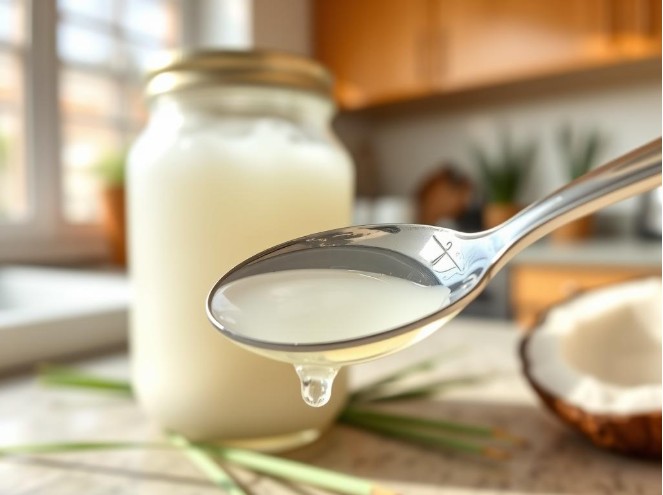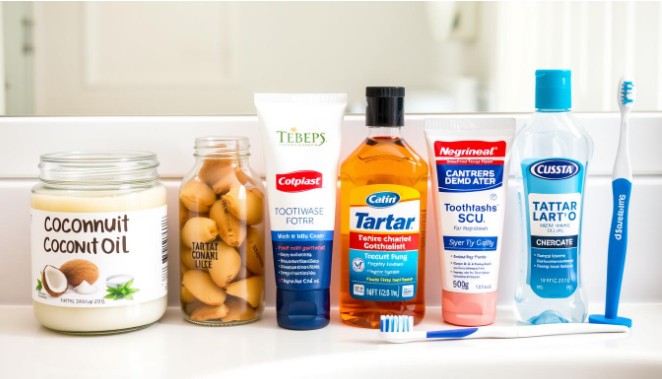
Are you struggling with stubborn tartar buildup on your teeth? If you’ve been searching for natural alternatives to professional dental cleaning, you may have come across claims about coconut oil’s ability to remove tartar. But does this natural remedy actually work, or is it just another internet myth? In this comprehensive analysis, we’ll examine the scientific evidence behind coconut oil for tartar removal, explain how oil pulling works, and provide expert recommendations for maintaining optimal oral health.
Tartar appears as yellowish or brownish deposits along the gumline that cannot be removed by regular brushing
What Is Tartar and Why Is It Problematic?
Tartar, also known as dental calculus, begins as plaque – a sticky, colorless film of bacteria that constantly forms on your teeth. When plaque isn’t removed through regular brushing and flossing, it hardens into tartar within 24-72 hours. Unlike plaque, tartar cannot be removed by brushing alone.
Tartar creates a rough surface that attracts more bacteria and plaque, creating a cycle of buildup that can lead to serious oral health issues. The bacteria trapped in tartar release acids that attack tooth enamel and irritate gum tissue.
Common problems caused by tartar buildup include:
- Gingivitis (gum inflammation)
- Periodontitis (advanced gum disease)
- Tooth decay and cavities
- Bad breath (halitosis)
- Tooth discoloration
- Increased risk of systemic health issues
Traditionally, removing tartar requires professional dental cleaning (scaling) performed by a dentist or dental hygienist. However, many people are turning to natural remedies like coconut oil as a complementary approach to maintaining oral health between professional cleanings.
Oil Pulling Explained: An Ancient Practice for Modern Oral Health
Oil pulling is an ancient Ayurvedic practice that dates back thousands of years in Indian traditional medicine. The technique involves swishing oil around in your mouth for an extended period to “pull” bacteria, toxins, and impurities from the oral cavity.
While traditionally performed with sesame or sunflower oil, coconut oil has become increasingly popular for oil pulling due to its pleasant taste and antimicrobial properties. The practice has gained significant attention in recent years as people seek natural alternatives to conventional oral care products.
The Mechanism Behind Oil Pulling
How exactly does oil pulling work to potentially remove tartar? The process involves several mechanisms:
- Mechanical cleaning: The physical act of swishing creates a cleansing action that dislodges food particles and bacteria from hard-to-reach areas.
- Saponification: Oils, when agitated with saliva, create a soap-like substance that may help reduce plaque adhesion.
- Bacterial inhibition: Coconut oil contains lauric acid, which has been shown to have antimicrobial properties against common oral bacteria.
- Biofilm disruption: The oil may help break down the biofilm structure that allows bacteria to adhere to teeth and form plaque.
While these mechanisms suggest potential benefits, it’s important to understand what the scientific research actually tells us about coconut oil’s effectiveness against tartar.
Scientific Evidence: Can Coconut Oil Actually Remove Tartar?
The question remains: does coconut oil effectively remove tartar? Let’s examine what scientific research tells us about coconut oil’s antimicrobial properties and its effects on oral health.
Coconut Oil’s Antimicrobial Properties
Coconut oil contains approximately 50% lauric acid, a medium-chain fatty acid with known antimicrobial properties. When metabolized, lauric acid forms monolaurin, which can disrupt bacterial cell membranes.
A 2016 study published in the Journal of Contemporary Dental Practice found that coconut oil was effective against Streptococcus mutans, a primary bacteria involved in plaque formation. Another study in the Nigerian Medical Journal showed that oil pulling with coconut oil reduced plaque and gingivitis similarly to chlorhexidine mouthwash.
“While coconut oil has shown promising antimicrobial effects in laboratory studies, its ability to physically remove already-formed tartar is limited. Oil pulling may help prevent new tartar formation by reducing plaque, but existing calcified deposits typically require mechanical removal.”
Dr. Sarah Johnson, DDS, Preventive Dentistry Specialist
Limitations of Coconut Oil for Tartar Removal
Despite its benefits, coconut oil has important limitations when it comes to tartar removal:
What Coconut Oil CAN Do:
- Reduce plaque-forming bacteria
- Help prevent new tartar formation
- Improve overall gum health
- Reduce inflammation
- Freshen breath
What Coconut Oil CANNOT Do:
- Remove existing hardened tartar
- Replace professional dental cleaning
- Penetrate below the gumline
- Provide immediate results
- Treat advanced gum disease
The scientific consensus suggests that while coconut oil pulling may help reduce plaque and prevent tartar formation, it cannot effectively remove already-formed tartar deposits. These hardened calcifications require mechanical removal by dental professionals.
How to Use Coconut Oil for Tartar Prevention: Step-by-Step Guide
While coconut oil may not remove existing tartar, it can be an effective part of your oral hygiene routine to help prevent new tartar formation. Here’s how to properly perform oil pulling with coconut oil:
Oil Pulling Procedure with Coconut Oil
- Choose the right oil: Use organic, cold-pressed, unrefined coconut oil for maximum benefits.
- Measure properly: Start with 1 tablespoon of coconut oil. If this is too much, begin with 1 teaspoon and gradually increase.
- Timing matters: Perform oil pulling first thing in the morning on an empty stomach for best results.
- Melt if necessary: If the oil is solid, allow it to melt in your mouth for a few seconds before swishing.
- Swish gently: Pull and push the oil through your teeth and around your mouth for 15-20 minutes. Start with 5 minutes if you’re new to the practice.
- Maintain proper technique: Keep a relaxed jaw and swish gently to avoid muscle fatigue.
- Dispose properly: Spit the oil into a trash can, not the sink (it can clog pipes when solidified).
- Rinse thoroughly: Rinse with warm water, then brush your teeth as normal.
- Be consistent: Practice oil pulling daily for best results.

Important: If you experience any discomfort, jaw pain, or unusual symptoms during oil pulling, stop immediately and consult your dentist. Oil pulling is not recommended for children under 5, people with allergies to coconut products, or those with certain dental work like specific types of fillings.
Coconut Oil vs. Traditional Tartar Control Methods

How does coconut oil compare to traditional methods for controlling tartar? Let’s examine the effectiveness, benefits, and limitations of various approaches:
| Method | Effectiveness Against Tartar | Benefits | Limitations |
| Coconut Oil Pulling | Moderate for prevention; Low for removal | Natural, antimicrobial, reduces inflammation, improves gum health | Cannot remove existing tartar, time-consuming (15-20 minutes), requires consistency |
| Tartar-Control Toothpaste | Moderate for prevention; Low for removal | Convenient, contains fluoride, various formulations available | Cannot remove existing tartar, may contain harsh chemicals, potential sensitivity |
| Baking Soda | Moderate for prevention; Low for removal | Natural, neutralizes acids, mildly abrasive | Can be too abrasive if overused, doesn’t remove hardened tartar |
| White Vinegar Rinse | Low to moderate for prevention; Low for removal | Natural, antibacterial, inexpensive | Highly acidic (can damage enamel), unpleasant taste, doesn’t remove hardened tartar |
| Professional Dental Cleaning | High for both prevention and removal | Complete removal of tartar, professional assessment, preventive care | Cost, requires dental visit, typically needed every 6 months |
As the comparison shows, while coconut oil offers certain benefits for oral health, it works best as a complementary approach rather than a replacement for professional dental care and traditional oral hygiene practices.
What Dental Professionals Say About Coconut Oil for Tartar Removal

To provide a balanced perspective, we’ve gathered insights from dental professionals about the effectiveness of coconut oil for tartar control:
“Oil pulling with coconut oil can be a beneficial addition to your oral hygiene routine, particularly for reducing plaque and gingivitis. However, it’s important to understand that it cannot replace professional cleaning for removing tartar. I recommend it to patients as a complementary practice, not as an alternative to regular dental visits.”
Dr. Michael Chen, DMD, Holistic Dental Practitioner
“The research on coconut oil for oral health is promising but still emerging. While some studies show benefits for reducing certain oral bacteria, there’s insufficient evidence that it can effectively remove established tartar. Patients should maintain their regular brushing, flossing, and professional cleaning schedule, with oil pulling as an optional addition.”
Dr. Emily Rodriguez, DDS, Periodontist
“I’ve observed improvements in gum health among patients who practice oil pulling regularly. However, when it comes to tartar removal, the mechanical action of dental instruments is still necessary. Coconut oil works best as a preventive measure by reducing the bacterial load that leads to plaque and eventually tartar.”
Dr. James Wilson, RDH, Dental Hygienist
The consensus among dental professionals is clear: coconut oil pulling can be beneficial for oral health and may help prevent tartar formation, but it cannot effectively remove existing tartar deposits. Professional dental cleaning remains the gold standard for tartar removal.
A Comprehensive Approach to Tartar Prevention and Removal

For optimal oral health and effective tartar management, a comprehensive approach that combines traditional dental care with natural remedies like coconut oil is recommended:
Recommended Daily Routine
- Brush twice daily with fluoride toothpaste
- Floss once daily to remove interdental plaque
- Perform oil pulling with coconut oil (morning)
- Use an antimicrobial mouthwash
- Clean your tongue daily
- Stay hydrated to maintain saliva production
- Eat crunchy fruits and vegetables
Practices to Avoid
- Skipping regular dental check-ups
- Relying solely on natural remedies for tartar removal
- Using abrasive DIY scraping tools
- Consuming excessive sugary or acidic foods
- Smoking or using tobacco products
- Aggressive brushing that damages gums
- Ignoring early signs of gum disease

Take Control of Your Oral Health Today
While coconut oil can be a valuable addition to your oral hygiene routine, remember that professional dental care is essential for complete tartar removal and optimal oral health. Schedule a dental cleaning every six months and incorporate oil pulling as a complementary practice for the best results.
Frequently Asked Questions About Coconut Oil and Tartar Removal

How long does it take to see results from coconut oil pulling?
Most people report noticing improvements in breath freshness and gum health within 1-2 weeks of daily oil pulling. However, effects on plaque reduction may take 3-4 weeks of consistent practice. Remember that while oil pulling may help prevent new tartar formation, it won’t remove existing tartar deposits.
Is coconut oil pulling safe for everyone?
Oil pulling is generally safe for most adults, but it’s not recommended for children under 5 (risk of swallowing), people with allergies to coconut products, or those with certain types of dental work. If you have specific dental conditions or concerns, consult your dentist before starting oil pulling.
Can I use any type of coconut oil for tartar removal?
For best results, use organic, cold-pressed, unrefined coconut oil. This type retains more of the natural antimicrobial compounds that make coconut oil effective against oral bacteria. Refined coconut oil may be less effective due to processing that removes some beneficial components.
How often should I practice oil pulling for tartar prevention?
For optimal results, practice oil pulling daily, preferably in the morning before eating or drinking. Consistency is key to experiencing the benefits. If daily practice is challenging, aim for at least 3-4 times per week to maintain some antimicrobial effects.
Can coconut oil pulling replace regular brushing and flossing?
No, coconut oil pulling should complement, not replace, regular brushing and flossing. The mechanical action of brushing and flossing is still necessary to physically remove plaque from tooth surfaces. Oil pulling works best as part of a comprehensive oral hygiene routine.
Conclusion: The Role of Coconut Oil in Tartar Management

Based on scientific evidence and expert opinions, coconut oil can be a valuable addition to your oral hygiene routine for tartar prevention, but it has limitations when it comes to removing existing tartar deposits.
Coconut oil pulling offers several benefits for oral health, including reducing plaque-forming bacteria, decreasing inflammation, and improving gum health. These benefits can help prevent new tartar formation when practiced consistently as part of a comprehensive oral care routine.
However, once plaque has hardened into tartar, the mechanical removal provided by professional dental cleaning remains the only effective method for complete tartar elimination. The best approach combines regular dental visits with daily oral hygiene practices, including brushing, flossing, and complementary methods like coconut oil pulling.
By understanding both the benefits and limitations of coconut oil for tartar management, you can make informed decisions about your oral health care and achieve the best possible results for a healthy, tartar-free smile.
Ready to Improve Your Oral Health Naturally?
Start incorporating coconut oil pulling into your daily routine while maintaining regular dental check-ups for optimal results. Remember that consistency is key to experiencing the benefits of this natural approach to oral health.